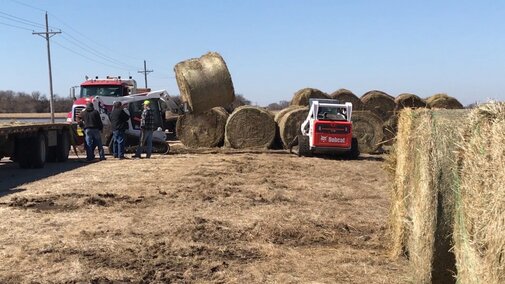Nebraska Extension is calling on farmers, municipalities, lawn care companies and others to donate or sell wood chips, hay, lawn waste and other carbon sources to livestock producers hit hard by COVID-19.
Livestock producers – particularly swine producers – are being faced with having to euthanize animals as meat processing plants have reduced or temporarily halted processing of livestock due to COVID-19. Composting is one of several ways that producers can dispose of animal carcasses, but most don’t have access to the large amounts of carbon, such as mulch, hay, manure or lawn waste, needed to safely perform composting of large volumes of carcasses.
Extension specialists Dr. Benny Mote and Dr. Amy Schmidt worked with University of Nebraska-Lincoln web developers to launch DisasterCARE.unl.edu, a site that allows municipalities, businesses, or individuals with carbon materials to list their available products, and for producers to search for needed materials.
“This is an extremely difficult spot for producers to be in, both financially and emotionally,” said Mote. “Helping connect producers with a carbon source gives them one less thing to worry about.”
Those who wish sell or donate carbon sources can visit DisasterCARE.unl.edu, create an account, and fill out a simple form in which they provide information on the type of carbon they can provide, how much they have, where they are located and whether they can assist with loading or delivery. Producers in need can create an account to view and connect with suppliers of carbon sources.
Example carbon sources:
- Lawn Waste
- Wood Chips or Mulch
- Sawdust or Wood Shavings
- Crop Residue (corn stover, wheat residue, etc)
- Legume Hay
- Non-Legume Hay
- Feedlot Manure
- Manure-Bedding Mixture
“It’s a very simple tool, but critically important,” said Ashley Mueller, Nebraska Extension disaster educator. “We all remember the outpouring of hay donations to help Nebraska farmers affected by the 2019 floods feed their livestock. Producers this year are facing a new set of challenges, and we hope that Nebraskans will once again step up and lend a helping hand.”
Additional resources for swine producers affected by COVID-19 are available at animalscience.unl.edu/swine, including information about financial assistance for impacted producers. COVID-19 information related to crop production is available at https://cropwatch.unl.edu/tags/covid-19. Additionally, Nebraska Extension has compiled resources for families, individuals, businesses, and producers at disaster.unl.edu/coronavirus-covid-19-resources.

